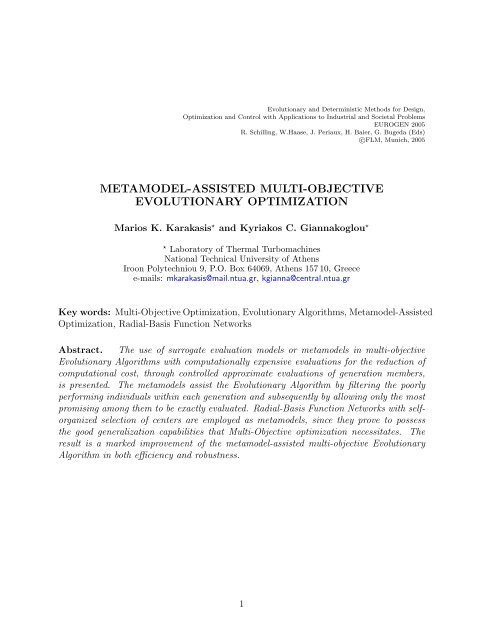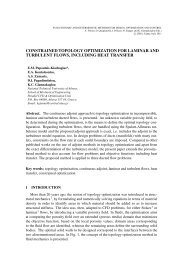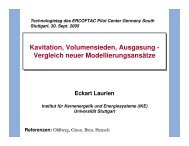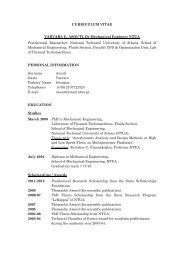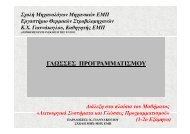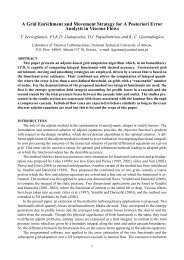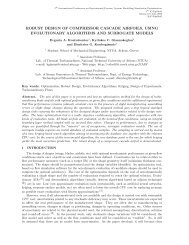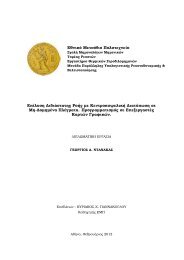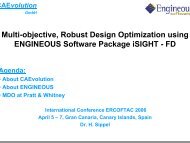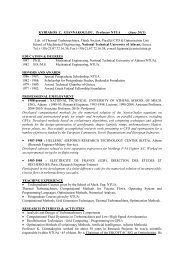Metamodel-Assisted Multi-Objective Evolutionary Optimization
Metamodel-Assisted Multi-Objective Evolutionary Optimization
Metamodel-Assisted Multi-Objective Evolutionary Optimization
You also want an ePaper? Increase the reach of your titles
YUMPU automatically turns print PDFs into web optimized ePapers that Google loves.
<strong>Evolutionary</strong> and Deterministic Methods for Design,<br />
<strong>Optimization</strong> and Control with Applications to Industrial and Societal Problems<br />
EUROGEN 2005<br />
R. Schilling, W.Haase, J. Periaux, H. Baier, G. Bugeda (Eds)<br />
c○FLM, Munich, 2005<br />
METAMODEL-ASSISTED MULTI-OBJECTIVE<br />
EVOLUTIONARY OPTIMIZATION<br />
Marios K. Karakasis ⋆ and Kyriakos C. Giannakoglou ⋆<br />
⋆ Laboratory of Thermal Turbomachines<br />
National Technical University of Athens<br />
Iroon Polytechniou 9, P.O. Box 64069, Athens 157 10, Greece<br />
e-mails: mkarakasis@mail.ntua.gr, kgianna@central.ntua.gr<br />
Key words: <strong>Multi</strong>-<strong>Objective</strong> <strong>Optimization</strong>, <strong>Evolutionary</strong> Algorithms, <strong>Metamodel</strong>-<strong>Assisted</strong><br />
<strong>Optimization</strong>, Radial-Basis Function Networks<br />
Abstract. The use of surrogate evaluation models or metamodels in multi-objective<br />
<strong>Evolutionary</strong> Algorithms with computationally expensive evaluations for the reduction of<br />
computational cost, through controlled approximate evaluations of generation members,<br />
is presented. The metamodels assist the <strong>Evolutionary</strong> Algorithm by filtering the poorly<br />
performing individuals within each generation and subsequently by allowing only the most<br />
promising among them to be exactly evaluated. Radial-Basis Function Networks with selforganized<br />
selection of centers are employed as metamodels, since they prove to possess<br />
the good generalization capabilities that <strong>Multi</strong>-<strong>Objective</strong> optimization necessitates. The<br />
result is a marked improvement of the metamodel-assisted multi-objective <strong>Evolutionary</strong><br />
Algorithm in both efficiency and robustness.<br />
1
Marios K. Karakasis and Kyriakos C. Giannakoglou<br />
1 INTRODUCTION<br />
Real-word problems such as aerodynamic shape designs can be solved using either<br />
gradient-based or global search (<strong>Evolutionary</strong> Algorithms, Simulated Annealing, etc.)<br />
methods. In the literature, adequate evidence concerning advantages and disadvantages of<br />
both can be found [1]. This paper deals exclusively with <strong>Evolutionary</strong> Algorithms (EAs).<br />
Despite the convenience of using EAs, which can readily accommodate any ready-touse<br />
evaluation software, their utilization in optimization problems becomes prohibitively<br />
expensive if a single evaluation is computationally expensive.<br />
A known remedy to the aforementioned drawback is through the use of surrogate<br />
evaluation models or metamodels. <strong>Metamodel</strong>s require training and, for this purpose, an<br />
adequate set of already evaluated solutions must be available. The metamodel type along<br />
with the training set determine its prediction abilities and the training cost. In the context<br />
of the so-called metamodel-assisted EAs, the way the metamodels should be employed<br />
during the evolution is of particular importance. The first class of metamodel-assisted<br />
EAs utilizes a metamodel which is trained in advance, separately from the evolution,<br />
after generating the necessary training data. The evolution,which relies on the off-line<br />
trained metamodel, produces an ‘optimal’ solution. This needs to be cross-validated and,<br />
depending on the associated error, the metamodel might be updated to support a new<br />
search cycle [2, 3] and so forth. The second class uses on-line trained metamodels and the<br />
exact evaluation tool to selectively support the evolution. The metamodel is continuously<br />
retrained during the evolution and, thus, it profits of the most recently collected data<br />
[4, 5, 6]. A method for employing metamodels as substitutes for the exact model has also<br />
been proposed by the authors for single-objective optimization (SOO) problems [7, 8, 9].<br />
A distinguishing feature of this method is the Inexact Pre-Evaluation (IPE) task. With<br />
the exception of the very first (usually one to three) generations, which are based on the<br />
exact evaluation tool in order to start populating the training set, in any subsequent<br />
generation and for each new candidate solution a local metamodel is trained on the available<br />
information in its neighbourhood. So, all population members are approximately<br />
evaluated using local metamodels and only the most promising among them are then<br />
re-evaluated using the exact tool. The latter are, of course, recorded and can be used as<br />
training patterns in the forthcoming generations.<br />
In what follows this filtering process of IPE is incorporated into <strong>Multi</strong>-<strong>Objective</strong> EAs<br />
(MOEAs) and the gain in both efficiency and robustness is demonstrated through appropriate<br />
test-cases.<br />
2 FILTERING THE INDIVIDUALS OF A MULTI-OBJECTIVE EVOLU-<br />
TIONARY ALGORITHM<br />
The purpose of using inexact pre-evaluations is to filter the poorly performing individuals<br />
in the population of each generation and to direct only the promising ones to the<br />
exact evaluation tool. The implementation of IPE in a MOEA can be abridged to the<br />
2
Marios K. Karakasis and Kyriakos C. Giannakoglou<br />
Evolution Operators<br />
No<br />
Convergence<br />
Yes<br />
Stop<br />
Initialization<br />
New<br />
Population<br />
Fitness Assignment<br />
(mixed exact and inexact)<br />
No<br />
Nondominated<br />
inexact?<br />
Yes<br />
Build local<br />
<strong>Metamodel</strong>s<br />
Data<br />
Base<br />
Evaluation of the<br />
non-dominated<br />
offspring with the<br />
Exact Model<br />
Evaluations using the<br />
<strong>Metamodel</strong>s<br />
Figure 1:<br />
The Inexact Pre-Evaluation in <strong>Multi</strong>-<strong>Objective</strong> <strong>Evolutionary</strong> Algorithms.<br />
following steps (cf. Fig. 1):<br />
Step 1 [Offspring evaluation] In a conventional MOEA, all offspring need to be exactly<br />
evaluated. Instead, IPE introduces the following substeps:<br />
Step 1a<br />
Step 1b<br />
Evaluate all offspring using locally built metamodels.<br />
Evaluate the non-dominated among them with the exact model.<br />
Step 1c If any non-dominated inexactly evaluated individuals still exist and a<br />
maximum permitted number of exact evaluations per generation has not been<br />
exceeded, repeat from Step 1b.<br />
Step 2 [Evolution] Form the next generation as though it were a conventional EA [10,<br />
11], by indiscriminately treating exact and inexact objective function values:<br />
1. Assign a cost function value to every individual, based on either sharing techniques<br />
[12, 13, 14] or the strength concept [15, 16, 17].<br />
2. Update the elit front and apply elitism.<br />
3. Select parents.<br />
4. Recombine parents and mutate their offspring.<br />
Step 3 [Termination] Proceed to Step 1, unless a termination criterion is met.<br />
3
Marios K. Karakasis and Kyriakos C. Giannakoglou<br />
RBFN using the underlying<br />
centers and radii.<br />
Self-organized placement of the<br />
centers with feedback from<br />
the performance of the<br />
overlaying RBFN.<br />
Centers<br />
Figure 2:<br />
Training Patterns<br />
A self-organized Radial-Basis Function Network.<br />
An important point in applying IPE in MOEAs is the selection of the individuals to be<br />
exactly evaluated after a pre-evaluation has been obtained, which is not as straightforward<br />
as in single-objective EAs. Steps 1a to 1c above imply a loop from which a non-predefined<br />
number of exact evaluations per generation results. It depends rather on the approximation<br />
error of the metamodels. This scheme is generally more computationally demanding<br />
than the one obtained by assigning a provisional cost value by a sharing or strength technique<br />
and exactly evaluating a predefined percentage of the best fit individuals [18, 19].<br />
It turns out, however, to be more robust in cases where the metamodels are confronted<br />
to a considerable number of failures of the exact evaluation tool. These failures do occur<br />
in real-world optimization problems, especially in combination with wide variable ranges,<br />
necessary at early design stages, and may be due to severe constraint violations or failures<br />
in grid generation, solver convergence etc.<br />
3 RADIAL-BASIS FUNCTION NETWORKS AS PRE-EVALUATORS<br />
The role undertaken by the metamodels in MOO, where a front of non-dominated<br />
solutions is sought, is considerably harder than in SOO. The reason lies in the fact that the<br />
population remains spread over a relatively extended area of the search domain throughout<br />
the evolution [18]. Radial-Basis Function Networks (RBFNs) possess valuable attributes<br />
for function approximation [20, 21, 22] and in the context of IPE, by employing local<br />
metamodels, they can be trained fast.<br />
In their simple form, however, where they merely interpolate the training patterns, are<br />
inadequate for use in MOO. The reason is the poor generalization performance. More<br />
elaborate variants can be used instead, which permit a self-organized placement of the<br />
RBF centers and subsequently the RBF radii determination. Such variants can be created<br />
by coupling RBFNs with Self-Organizing Maps or Growing Neural Gas models [23, 24,<br />
4
Marios K. Karakasis and Kyriakos C. Giannakoglou<br />
1,0<br />
0,9<br />
Training Patterns<br />
Testing Patterns<br />
RBF centers and NG topology<br />
0,8<br />
0,7<br />
0,6<br />
x 2<br />
0,5<br />
0,4<br />
0,3<br />
0,2<br />
0,1<br />
0,1 0,2 0,3 0,4 0,5 0,6 0,7 0,8<br />
x 1<br />
Figure 3: Positioning the Radial-Basis<br />
Function centers with the Neural Gas<br />
(NG) model.<br />
25, 26, 27] and in what follows will be denoted as self-organized RBFNs to distinguish<br />
them from the simple RBFNs that interpolate the training patterns. The notion of the<br />
self-organized RBFN is depicted in Fig. 2. An example of positioning the RBF centers<br />
with the Neural Gas model is illustrated in Fig. 3. Note that the RBF centers are not<br />
neccessarily placed at the high pattern density areas but where it is needed to improve<br />
the RBFN performance, monitored by the testing patterns.<br />
4 APPLICATION IN MULTI-OBJECTIVE OPTIMIZATION<br />
The impact of using metamodels in MOEAs on the computational cost will be demonstrated<br />
in the following test-cases, one numerical and one in the field of turbomachinery.<br />
The effect of using self-organized RBFNs will be put forward in contradistinction to the<br />
use of simple RBFNs as metamodels, in order to stress the importance of the metamodel<br />
generalization capability in MOO.<br />
To assess the front quality, the objective space is overlaid with a grid of 200 points per<br />
objective. As quality measure of a front, the number of grid points that are not dominated<br />
by the front members is used. Apparently, the lower the measure, the better the front.<br />
4.1 Numerical example<br />
The first case, defined in INGENET (EU Thematic Network), consists in the minimization<br />
of the following multimodal functions:<br />
F j (x) = 4 √ √√√<br />
1<br />
n<br />
n∑<br />
{(x i − a j ) 2 − 10 cos[2π(x i − a j )]} , j = 1, 2<br />
i=1<br />
with<br />
a 1 = 0.0, a 2 = 1.5, x ∈ [−5, 5] n , n = 30<br />
5
Marios K. Karakasis and Kyriakos C. Giannakoglou<br />
Non-dominated grid points<br />
3,24x10 4<br />
3,22x10 4<br />
3,20x10 4<br />
3,18x10 4<br />
3,16x10 4<br />
3,14x10 4<br />
3,12x10 4<br />
Conventional EA<br />
EA-IPE, simple RBFNs<br />
EA-IPE, self-organized RBFNs<br />
0 500 1000 1500 2000<br />
Exact evaluations<br />
(a) Front assessment by counting the nondominated<br />
grid points by each front.<br />
F 2<br />
2,1<br />
2,0<br />
1,9<br />
1,8<br />
1,7<br />
1,6<br />
1,5<br />
F 1<br />
Conventional EA<br />
EA-IPE, self-organized RBFNs<br />
1,5 1,6 1,7 1,8 1,9 2,0 2,1<br />
(b) Final fronts of non-dominated solutions.<br />
Figure 4:<br />
Numerical example: Convergence history and fronts after 2000 exact evaluations.<br />
The improved performance of the self-organized RBFNs results in more effective filtering<br />
of the population individuals within each generation and consequently in higher<br />
quality front with the same computational cost as a conventional EA (Fig. 4). Note that<br />
the same efficiency is not achievable with metamodels with low generalization capability,<br />
such as simple RBFNs (Fig. 4(a)).<br />
4.2 Shape optimization of a compressor cascade<br />
The second case aims at minimizing the total pressure losses of a controlled diffusion<br />
compressor cascade airfoil, while maintaining acceptable performance at off-design inlet<br />
flow angles. These two confronting objectives have been formulated as the minimization<br />
problem of<br />
F 1 = ω β1,DOP = p 01 − p 02<br />
p 01 − p 1<br />
∑n off<br />
F 2 = 10 4 · (ω β1,i − ω β1,DOP ) 2<br />
i=1<br />
where indices 1, 2 refer to the inlet and outlet planes respectively and DOP to design<br />
operating point. n off denotes the number of off-design points examined.<br />
The design operating conditions of the reference airfoil were: M 1 = 0.62, β 1,DOP = 47 o<br />
and Re = 8.41 · 10 5 . Two off-design points were computed for each airfoil design, namely<br />
at β 1,1 = 43 o and β 1,2 = 51 o . The flow field was computed with an integral boundary<br />
layer method (MISES, [28]).<br />
Design variables were the positions of the NURBS control points of the parametrized<br />
airfoil, as illustrated in Fig. 5. Geometrical constraints were (a) the max. airfoil thickness<br />
6
Marios K. Karakasis and Kyriakos C. Giannakoglou<br />
0,24<br />
0,20<br />
0,16<br />
0,12<br />
0,08<br />
y/c<br />
0,04<br />
0,00<br />
-0,04<br />
-0,08<br />
-0,2 0,0 0,2 0,4 0,6 0,8 1,0<br />
x/c<br />
Figure 5: Compressor cascade: The reference cascade<br />
profile parametrized with NURBS, along with<br />
the bound boxes of the design variables.<br />
Non-dominated grid points<br />
7,00x10 3<br />
6,00x10 3<br />
5,00x10 3<br />
4,00x10 3<br />
3,00x10 3<br />
Conventional EA<br />
EA-IPE, simple RBFNs<br />
EA-IPE, self-organized RBFNs<br />
2,00x10 3<br />
0 500 1000 1500 2000<br />
Exact evaluations<br />
Figure 6: Compressor cascade:<br />
Convergence history.<br />
(not less than 10% of the chord), (b) the airfoil thickness at 80% of the chord, (c) the<br />
curvature of pressure/suction sides (PS/SS) at the leading edge (LE), (d) the angle between<br />
the first PS/SS control points and the LE. Aerodynamic constraint was the flow<br />
exit angle β 2 , which should be between 19 o and 21 o . All constraints were imposed via<br />
penalty function multipliers.<br />
Compared to the previous case, additional difficulties arise due to the numerous constraints<br />
and the inability of the flow solver to compute (massively) separated flows, which<br />
are likely to occur at off-design conditions. These difficulties result in a high number of<br />
failing evaluations; indeed, approximately 350 out of the 2000 evaluations failed. Nevertheless<br />
IPE was not inhibited from reducing the computational effort required for a given<br />
front quality, as Fig. 6 shows. In Fig. 7 the front obtained from EA-IPE is superposed to<br />
the one achieved by a conventional EA and a number of representative solutions belonging<br />
to the front are presented.<br />
7
Marios K. Karakasis and Kyriakos C. Giannakoglou<br />
30<br />
Airfoil obtained from SOO<br />
without off-design performance<br />
considerations<br />
Conventional EA<br />
EA-IPE<br />
0,20<br />
0,18<br />
25<br />
20<br />
y/c<br />
0,16<br />
0,14<br />
0,12<br />
0,10<br />
0,08<br />
0,06<br />
0,04<br />
0,02<br />
0,00<br />
Reference airfoil<br />
Optimized airfoil<br />
NURBS control points<br />
-0,02<br />
0,18<br />
0,0 0,2 0,4 0,6 0,8 1,0<br />
x/c<br />
0,16<br />
0,14<br />
15<br />
0,12<br />
0,10<br />
0,08<br />
0,20<br />
F 2<br />
y/c<br />
0,06<br />
0,04<br />
0,18<br />
0,16<br />
0,14<br />
0,02<br />
0,12<br />
10<br />
0,00<br />
-0,02<br />
0,0 0,2 0,4 0,6 0,8 1,0<br />
x/c<br />
y/c<br />
0,10<br />
0,08<br />
0,06<br />
0,04<br />
0,02<br />
5<br />
Reference<br />
cascade airfoil<br />
0,00<br />
-0,02<br />
-0,04<br />
0,0 0,2 0,4 0,6 0,8 1,0<br />
x/c<br />
0<br />
0,016 0,017 0,018 0,019 0,020 0,021 0,022<br />
F 1<br />
Figure 7: Compressor cascade: Fronts after 2000 exact evaluations and representative solutions obtained<br />
by an <strong>Evolutionary</strong> Algorithm using Inexact Pre-Evaluations.<br />
5 CONCLUSIONS<br />
The use of inexact pre-evaluations through appropriately on-line trained metamodels<br />
to single out the promising individuals of each generation, in order only these to be exactly<br />
evaluated, increases markedly both the efficiency and the robustness of multi-objective<br />
<strong>Evolutionary</strong> Algorithms. Due to the nature of multi-objective optimization treated with<br />
the Pareto front approach, the role undertaken by the metamodels is much harder compared<br />
to single-objective optimization. Good generalization properties are indispensable<br />
on behalf of the metamodels, and these should be attained by keeping the training cost<br />
low. Radial-Basis Function Networks with self-organized selection of centers fulfil this<br />
requirement and proved to assist successfully multi-objective <strong>Evolutionary</strong> Algorithms.<br />
Acknowledgements<br />
This research was sponsored by Dassault Aviation.<br />
The first author was supported by an A.S. Onassis Public Benefit Foundation Scholarship.<br />
The project was co-funded by the European Social fund (75%) and National Resources<br />
(25%) — Operational Program for Educational and Vocational Training II (EPEAEK II)<br />
and particularly the Program PYTHAGORAS.<br />
8
Marios K. Karakasis and Kyriakos C. Giannakoglou<br />
REFERENCES<br />
[1] Z. Michalewicz and D.B. Fogel. How to Solve it: Modern Heuristics. Springer, Berlin,<br />
1998.<br />
[2] W. Shyy, N. Papila, R. Vaidyanathan, and K. Tucker. Global design optimization<br />
for aerodynamics and rocket propulsion components. Progress in Aerospace Sciences,<br />
37:59–118, 2001.<br />
[3] Y. Ong, P. Lum, P. Nair, D. Shi, and Z. Zhang. Global convergence of unconstrained<br />
and bound constrained surrogate-assisted evolutionary search in aerodynamic shape<br />
design. In Proceedings of the 1999 Congress on <strong>Evolutionary</strong> Computation (CEC<br />
2003), Australia, 2003.<br />
[4] Y. Jin, M. Olhofer, and B. Sendhoff. A framework for evolutionary optimization with<br />
approximate fitness functions. IEEE Transactions on <strong>Evolutionary</strong> Computation,<br />
6(5), 2002.<br />
[5] H. Ulmer, F. Streichert, and A. Zell. Evolution strategies assisted by gaussian processes<br />
with improved pre-selection criterion. In Proceedings of the 1999 Congress on<br />
<strong>Evolutionary</strong> Computation (CEC 2003), Australia, 2003.<br />
[6] P. Nair and A. Keane. <strong>Evolutionary</strong> optimization of computationally expensive problems<br />
via surrogate modeling. AIAA Journal, 41(4):687–696, 2003.<br />
[7] K.C. Giannakoglou. Designing turbomachinery blades using evolutionary methods.<br />
ASME Paper 99-GT-181, 1999.<br />
[8] K.C. Giannakoglou, A.P. Giotis, and M.K. Karakasis. Low–cost genetic optimization<br />
based on inexact pre–evaluations and the sensitivity analysis of design parameters.<br />
Journal of Inverse Problems in Engineering, 9:389–412, 2001.<br />
[9] M.K. Karakasis, A.P. Giotis, and K.C. Giannakoglou. Inexact information aided,<br />
low-cost, distributed genetic algorithms for aerodynamic shape optimization. International<br />
Journal for Numerical Methods in Fluids, 43:1149–1166, 2003.<br />
[10] T. Bäck. <strong>Evolutionary</strong> Algorithms in Theory and Practice. Evolution Strategies,<br />
<strong>Evolutionary</strong> Programming, Genetic Algorithms. Oxford University Press, 1996.<br />
[11] T. Bäck. Handbook of <strong>Evolutionary</strong> Computation. Oxford University Press, New<br />
York, 1997.<br />
[12] N Srinivas and K. Deb. <strong>Multi</strong>objective optimization using nondominated sorting in<br />
genetic algorithms. <strong>Evolutionary</strong> Computation, pages 221–248, 1994.<br />
9
Marios K. Karakasis and Kyriakos C. Giannakoglou<br />
[13] C.M. Fonseca and P.J. Fleming. An overview of evolutionary algorithms in multiobjective<br />
optimization. <strong>Evolutionary</strong> Computation, 3(1):1–16, 1995.<br />
[14] J. Horn and N. Nafpliotis. <strong>Multi</strong>objective optimization using the Niched Pareto<br />
Genetic Algorithm. Technical Report IlliGAL 93005, University of Illinois at Urbana-<br />
Champaign, Illinois, USA, 1993.<br />
[15] E. Zitzler and L. Thiele. An evolutionary algorithm for multiobjective optimization:<br />
The strength Pareto approach. TIK-Report No. 43, Computer Engineering and<br />
Communication Networks Lab, ETH Zurich, 1998.<br />
[16] E. Zitzler, M. Laumanns, and L. Thiele. SPEA2 improving the Strength Pareto<br />
<strong>Evolutionary</strong> Algorithm. TIK-Report No. 103, Computer Engineering and Communication<br />
Networks Lab, ETH Zurich, 2001.<br />
[17] E. Zitzler, K. Deb, and L. Thiele. Comparison of multiobjective evolutionary algorithms:<br />
Empirical results. TIK-Report No. 70, Computer Engineering and Communication<br />
Networks Lab, ETH Zurich, 1999.<br />
[18] M. Karakasis and K.C. Giannakoglou. On the use of surrogate evaluation models in<br />
multi-objective evolutionary algorithms. In P. Neittaanmäki, T. Rossi, K. Majava,<br />
and O. Pironneau, editors, ECCOMAS 2004, volume 2, Jyväskylä, Finland, 2004.<br />
[19] K.C. Giannakoglou. Neural network assisted evolutionary algorithms, in aeronautics<br />
and turbomachinery. Von-Karman Institute Lecture Series 2004, November, 2004.<br />
[20] T. Poggio and F. Girosi. Networks for approximation and learning. Proceedings of<br />
the IEEE, 78(9):1481–1497, 1990.<br />
[21] J. Park and I.W. Sandberg. Universal approximation using radial-basis-function<br />
networks. Neural Computation, 3:246–257, 1991.<br />
[22] Simon Haykin. Neural Networks, A Comprehensive Foundation. Prentice Hall, 2nd<br />
edition, 1999.<br />
[23] N. Karayiannis and W. M. Glenn. Growing radial basis neural networks: Merging<br />
supervised and unsupervised learning with network growth techniques. IEEE<br />
Transactions on Neural Networks, 8(6):1492–1506, November 1997.<br />
[24] B. Fritzke. Fast learning with incremental RBF networks. Neural Processing Letters,<br />
1(1):2–5, 1994.<br />
[25] Teuvo Kohonen. Self-Organizing Maps. Springer, Berlin, 2nd edition, 1997.<br />
10
Marios K. Karakasis and Kyriakos C. Giannakoglou<br />
[26] T.M. Martinetz, S.G. Berkovich, and K.J. Schulten. Neural-gas network for vector<br />
quantization and its application to time-series prediction. IEEE Transactions on<br />
Neural Networks, 4:558–569, 1997.<br />
[27] B. Fritzke. Handbook of Neural Computation, chapter Unsupervised ontogenic networks,<br />
pages C2.4:1–C2.4:16. IOP Publishing and Oxford University Press, 1997.<br />
[28] M. Drela and M.B. Giles. Viscous–inviscid analysis of transonic and low Reynolds<br />
number airfoils. AIAA Journal, 25 (10):1347–1355, 1987.<br />
11


